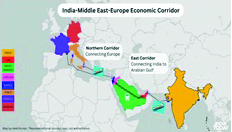New Delhi
Escalating tensions between Tel Aviv and Gaza have cast a shadow on the fate of the ambitious transcontinental infrastructure project, the India-Middle East-Europe Corridor (IMEEC) launched on the sidelines of the recent G20 summit in September. Largely being viewed as counter to China’s ‘One Belt, One Road’, the transit corridor is the outcome of deliberations of national security advisers of the US, Saudi Arabia, the UAE and India to discuss a joint project to link the Gulf countries with a railway network which will be well connected through sea-lanes with India.
Prabir Dey, Professor RIS, underlines the criticality of the proposed ‘land-bridge’ for improving connectivity of the region with India and Europe through multi-modal linkages between the USA, India, Japan, Saudi Arabia, UAE, France, Germany, Italy and the EU. “This captures a total GDP size of USD 39.33 trillion and a population of 2.01 billion of the seven economies put together,” Dey told the Sunday Guardian. “There is however no doubt that the project will be impacted by the crisis. The extent and gravity is to be seen from the prism of the advantages that the corridor brings and the mitigation measures to counter the risks,” sums up the RIS professor.
Prabir De’s is just one of the many voices of concern over the growing intensity of the war and impact on the progress of the corridor in terms of viability, cost and strategy, as well as the implications for exchange of goods and services and economic development. The core issue is that the tentative route is linked to Israel and while the entire plan for the IMEC project hasn’t been revealed yet, the signs of a prolonged conflict drawing in the Middle East has bearing on the construction works for the corridor. “The whole region is disturbed so there is possibility of the corridor being put on the backburner,” Pradeep S Mehta, Secretary General, CUTS International told the Sunday Guardian. “Implementation is one of the key issues which is going to be hit. There will be a huge economic cost to the conflict,” says Mehta.
This puts at risk several strategic calculations, chiefly, the IMEEC partners’ intent to enhance trade in the region alongwith the establishment of sea shipping and rail links from India across the Middle East and into Europe. The project brings on board — from the value point of commercial transit – a critical 35 per cent share in world trade of these countries put together, underlining the volume of trade that will be facilitated at a lesser cost and ease, points out Dey. The IMEEC would reduce the time and cost of transporting Indian goods to Europe by 40 per cent and 30 per cent, respectively, and vice versa.
The crisis also comes at a time when global dynamics favour such a project, in terms of demand for trade. India’s total trade with Saudi Arabia more than doubled in two years, with USD 53 billion in FY23. Ties between India and the Gulf have significantly warmed. India is looking to forge a stronger relationship with Europe, its third largest trading partner. However, the corridor requires a stable connection between Saudi Arabia and Israel before goods can be eventually shipped to Europe.
According to Ram Singh, Professor, Indian Institute of Foreign Trade, the USD 20 billion estimated cost of this extensive network covers a railway corridor, a hydrogen pipeline and high-density optical fibre cables. Once completed, it would establish a dependable and cost-effective ship-to-rail transit system for cross-border movement of goods and services. For India, the project offers an alternative transport route to the flourishing markets of the Middle-East and Europe for its outbound shipments. “For India’s engineering exports sector, both the Middle East and Europe are key markets, and having transport infrastructure of this scale will significantly enhance its competitiveness globally,” notes Arun Kumar Garodia, Chairman of the Engineering Export Promotion Council.
Prabir Dey points out the other attraction for India in this project, namely the business opportunities it will open up for Indian Railways with its proven expertise in building railway networks in deserts. “The Railways could get a major share of contracts in this proposed corridor as the existing UAE-Saudi-Amman rail network would need construction of an additional 300 km of network connecting Amman with port Haifa to get operationalised,” says Dey.
Moreover, the IMEEC is an integral part of the G7 strategy to mobilise USD 600 billion by 2027 for global infrastructure investments. This would entail providing sustained financing for the corridor.
The funding is proposed from the ‘build-back-better world (B3W)’ initiative and member-states’ infrastructure investments but given the extended planning phase of infrastructure projects, rise in costs due to expenses of a war and inflated costs could make it difficult to ensure consistent funding for projects. The resultant delays in fund allocation can lead to project delays, cost overruns and reduced viability. With India diversifying into other economic corridor projects, the move to even out the risks may act in India’s favour. De believes every global crisis offers opportunities and the IMEEC can well turn into one if effectively leveraged.

